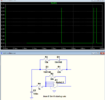Follow along with the video below to see how to install our site as a web app on your home screen.
Note: This feature may not be available in some browsers.

Do you know why the NOR osc attached isnt working?
No, you need to add it, or use a gate with the hysteresis built-in...and the real thing has this hysteresis
Look at my circuit again.Though i still cant get it working...
Hi,
Do you know why the NOR osc attached isnt working?...i think its something to do with race hazard?
Note that the oscillations are very high frequency (much higher than you would expect from the R and C values) because there is no hysteresis.See below
Note that the oscillations are very high frequency (much higher than you would expect from the R and C values) because there is no hysteresis.
Hi,
Do you know why the NOR osc attached isnt working?...i think its something to do with race hazard?

